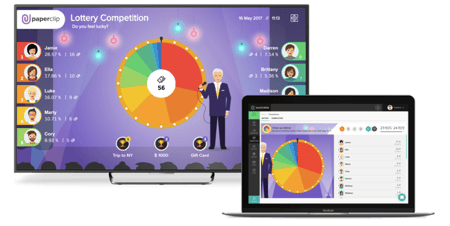6 ways gamification increases productivity

1. Ramp up the competition
Everyone likes to compete, right? If someone is next to you on the treadmill, you run a little faster. Likewise, if someone is closing more deals, you’re likely to up your game and start calling more customers in order to close more deals. Why? because humans are wired for competition. For example:
In a survey of faculty, students, and staff at the Harvard School of Public Health, nearly half of the respondents said they’d prefer to live in a world where the average salary was $25,000 and they earned $50,000 than one where they earned $100,000 but the average was $200,000.
Competition is an innate part of who we are as human beings. From a biological and historical perspective, we’ve competed since the beginning for everything from food and resources to Olympic games. We are hardwired to compete.
However, keep in mind that when competing small team sizes are more effective. According to the Association for Psychological Science, When there are few competitors, people can experience social-comparison, which fuels motivation to compete. But as the number of competitors increases, social comparison diminishes, dampening competitive feelings.
Researchers found that while one’s competitive motivation increases in a small group, it decreases significantly when a few competitors become many.
So, if you are going to use gamification to increase competitive instincts within your teams, ensure that it is done in small groups in fun ways with motivating rewards or acknowledgement for the finishers.
2. Make work more fun
Who doesn’t want to have more fun at work? Gamification is more than just a game; it allows leaders to leverage intrinsic and extrinsic motivation factors to inspire us to take action because the tasks are interesting and satisfying.
A well-designed gamification plan inspires employees to take action on clearly defined business goals because they are rewarded in ways that are meaningful, such as: recognition, praise, mastery of tasks and celebration of a job well done.
By measuring business impacts of key tasks and supporting the growth, development and improvement of action on these key tasks, gamification is an effective strategy to drive focused activity while also making the repetition of such activities more fun and enjoyable.
3. Speed up time to mastery
All of us should be striving for mastery in our jobs. Mastery is comprehensive knowledge or skill at something, allowing us to complete large tasks in shorter time with higher levels of quality. In order to achieve mastery, we need to repeat tasks many times over… but repetition is boring and tedious. So, how can you make it so that attaining mastery becomes simple, interesting, and fun? Turn it into a game.
When people receive recognition, accolades, rewards or other meaningful incentive for completing clearly defined tasks, it inspires better performance and higher motivation, which in turn results in more incentive to keep learning.
So, if you want employees to master specific tasks, then use gamification as a tool to motivate performance on clearly defined objectives. Next thing you know, you’ll have an office full of highly motivated rockstars!
4. Inspire collaboration
Similar to competition, collaboration inspires us to put forth extra effort, but in a slightly different way. Whereas competition pits us against each other–individually or in teams–collaboration sets common goals for a group to achieve together.
Gamification thus helps to build and culture of teamwork and fuels continuous progress for everyone. And since it also increases transparency (everyone can see how everyone is performing, when they complete tasks, make a sale, etc.), people are more likely to converse about theirs and others activities and contribute relevant knowledge whenever possible.
For example, say one of your co-workers makes a sale with an important client. You happen to have some insight about that particular client that can help with nurturing the relationship moving forward, so you head over to their desk and fill them in on what you know. Not only does this foster relationships within the office, it also helps to prevent churn and ultimately benefits the company bottom line.
5. Designate goals
There is a reason why so many people set goals when they want to achieve something. It inspires motivation and holds them more accountable in the completion of tasks. However, it is also common to abandon goals due to lack of clarity, specificity and frustration. Sales gamification makes goal-setting simple and targets explicit, which greatly increases the likelihood of accomplishing–and surpassing–both individual, team and company goals.
Specific, measurable goals with a time-constraint are proven to be the most effective. With gamification tools, you can easily implement assessable targets and indicate time limits–you can also set up recurring goals, for example weekly or monthly budgets.
6. Provide instant feedback
With millennials making up a large majority of the workforce, it is no wonder that the availability of real-time data and frequent, immediate feedback from managers has become a must for any successful organization.
Instant feedback gives people the opportunity to understand how they are performing and subsequently adapt their behavior if need be. If they are performing well they can celebrate and continue to progress, and if they are performing poorly they can quickly course-correct and identify patterns that could help them to improve in the future. Either way, employees have control and ownership over their performance and this will likely result in happier and more productive workers.
(RE-PUBLISHED FROM OUR FRIENDS AT SALESSCREEN.COM)
